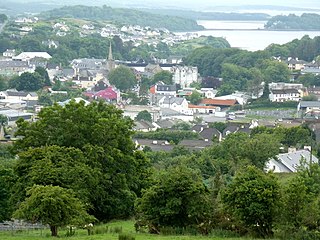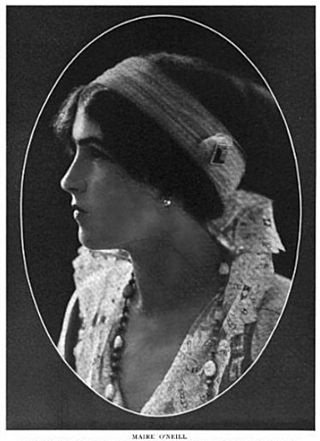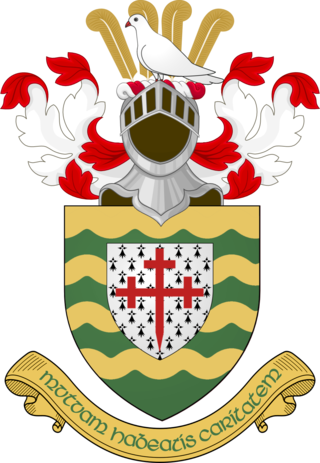
Brian Patrick Friel was an Irish dramatist, short story writer and founder of the Field Day Theatre Company. He had been considered one of the greatest living English-language dramatists. He has been likened to an "Irish Chekhov" and described as "the universally accented voice of Ireland". His plays have been compared favourably to those of contemporaries such as Samuel Beckett, Arthur Miller, Harold Pinter and Tennessee Williams.

Glenties is a town in County Donegal, Ireland. It is situated where two glens meet, north-west of the Bluestack Mountains, near the confluence of two rivers. Glenties is the largest centre of population in the parish of Iniskeel. Glenties has won the Irish Tidy Towns Competition five times in 1958, 1959, 1960, 1962 and 1995 and has won a medal many other times. As of 2016, the population is 805.

St Eunan's College, known locally as The College to distinguish it from the cathedral and GAA club, is a voluntary Roman Catholic all-male secondary day school in County Donegal, Ireland. It is located upon Sentry Hill in Letterkenny. Named after Adomnán or Eunan, the school's foundation stone was laid on the patron saint's feast day of 23 September.

Lifford is the county town of County Donegal, Ireland, the administrative centre of the county and the seat of Donegal County Council, although the town of Letterkenny is often mistaken as holding this role.

Clonmany is a village in north-west Inishowen, in County Donegal, Ireland. The area has a number of local beauty spots, while the nearby village of Ballyliffin is known for its golf course. The Urris valley to the west of Clonmany village was the last outpost of the Irish language in Inishowen. In the 19th century, the area was an important location for poitín distillation.

Donegal is a town in County Donegal, Ireland. The name was also historically spelt 'Dunnagall'. Although Donegal gave its name to the county, now Lifford is the county town. From the 15th until the early 17th century, Donegal was the 'capital' of Tyrconnell, a Gaelic kingdom controlled by the O'Donnell dynasty of the Northern Uí Néill.
Events in the year 1964 in Ireland.

William Sydney Clements, 3rd Earl of Leitrim, was an Anglo-Irish nobleman and landlord notorious in Irish history for his mistreatment of his tenants. He was assassinated in the north of County Donegal in Ireland in April 1878.
Philadelphia, Here I Come! is a 1964 play by Irish dramatist Brian Friel. Set in the fictional town of Ballybeg, County Donegal, the play launched Friel onto the international stage.

Maire O'Neill was an Irish actress of stage and film. She holds a place in theatre history as the first actress to interpret the lead character of Pegeen Mike Flaherty in John Millington Synge's controversial masterpiece The Playboy of the Western World (1907).

Belfast Castle is a mansion located in Cave Hill Country Park in Belfast, Northern Ireland, in a prominent position 400 feet (120 m) above sea level. Its location provides unobstructed views over the City of Belfast and Belfast Lough. There have been several different structures called 'Belfast Castle' over the centuries, located on different sites. The current 'castle' is a Victorian structure, built between 1867 and 1870 on the slopes of Cave Hill, and is listed as being Grade B+. The main entrance into the Belfast Castle Demesne is now where Innisfayle Park meets Downview Park West, just off the Antrim Road. The original main entrance into the current demesne was formerly on the Antrim Road itself, where Strathmore Park now meets the Antrim Road.

The Gallagher family of County Donegal, formerly one of the leading clans of Ulster originated in the 10th century as a derivative of its progenitor Gallchobhair Mac Rorcan, a powerful chieftain of the Cenél Conaill and descendant of Niall of the Nine Hostages in the paternal line. The O'Gallaghers held the High Kingship of Ireland during the 6th and 7th centuries, and during the Middle Ages, were hereditary Marshals of the Kingdom of Tyrconnell, ruled by their kinsmen the O'Donnells.

Donegal County Council is the authority responsible for local government in County Donegal, Ireland. As a county council, it is governed by the Local Government Act 2001. The council is responsible for housing and community, roads and transportation, urban planning and development, amenity and culture, and environment. It has 37 elected members. Elections are held every five years and are by single transferable vote. The head of the council has the title of Cathaoirleach (Chairperson). The county administration is headed by a Chief Executive, John McLaughlin. The county town is Lifford.
Currow is a rural village in County Kerry in south west Ireland, located approximately 12 km from Killarney and 18 km from Tralee. Currow is situated on the Brown Flesk River, a tributary of the River Maine.
The High Sheriff of Clare was a High Sheriff title. Records show that the title was in existence from at least the late 16th century, though it is not used today in the modern Republic of Ireland. The title existed within County Clare in the west of Ireland during the time of the Kingdom of Ireland and then as part of the United Kingdom of Great Britain and Ireland.

Porthall is a village and townland in County Donegal, Ireland. The village is located on the west bank of the River Foyle, in The Laggan district of East Donegal, on the R265 road. The nearest town is Lifford, the county town.
Connor O'Brien, King of Thomond was the second to last King of Thomond.
The High Sheriff of Leitrim was the British Crown's judicial representative in County Leitrim, Ireland from c.1582 until 1922, when the office was abolished in the new Free State and replaced by the office of Leitrim County Sheriff. The sheriff had judicial, electoral, ceremonial and administrative functions and executed High Court Writs. In 1908, an Order in Council made the Lord-Lieutenant the Sovereign's prime representative in a county and reduced the High Sheriff's precedence. However the sheriff retained his responsibilities for the preservation of law and order in the county. The usual procedure for appointing the sheriff from 1660 onwards was that three persons were nominated at the beginning of each year from the county and the Lord Lieutenant then appointed his choice as High Sheriff for the remainder of the year. Often the other nominees were appointed as under-sheriffs. Sometimes a sheriff did not fulfil his entire term through death or other event and another sheriff was then appointed for the remainder of the year. The dates given hereunder are the dates of appointment. All addresses are in County Leitrim unless stated otherwise.

Lieutenant-Colonel Edward Henry Cooper was an Irish officer in the British Army, a landlord in County Sligo, and a Conservative politician.












